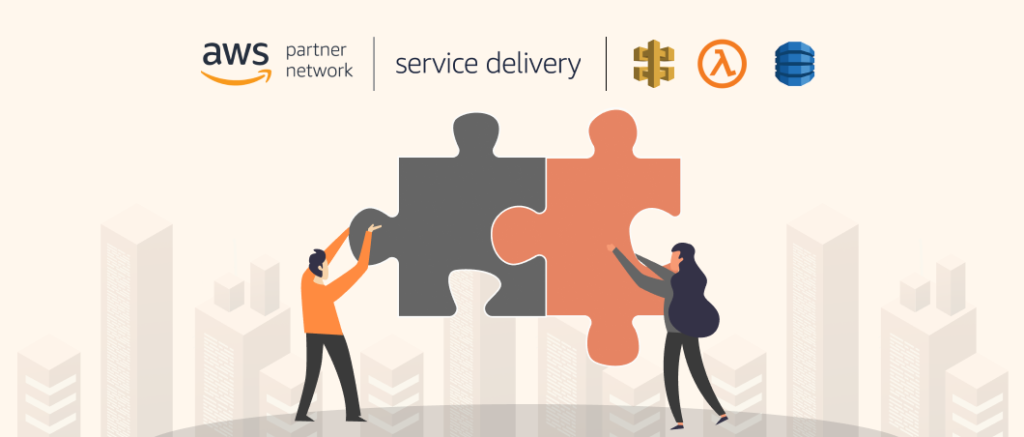Last updated on February 1st, 2022
Of late, we have found ourselves working increasingly on serverless approaches and have been helping organizations leverage this technology to add scalability and agility to their business. The benefits of serverless are clear, especially as it allows organizations to automatically run at scale applications based on immediate, individual requests. With the number of serverless projects increasing in our software development portfolio, moving on and adding the AWS Service Delivery partner certification was a natural progression.
Why did we embark on the AWS Service Delivery partner journey?
The decision to add AWS Service Delivery expertise was also because we believe that we are moving into that age when all products shall be cloud products. It’s true that one of the reasons to become an AWS Service Delivery partner was to formalize and codify a granular and comprehensive understanding of AWS. In fact, the process of getting certified as AWS Service Delivery partners helped us improve our technical expertise and gain deep knowledge of the latest AWS serverless offering’s features and best practices. We believe this will enable us to increase our time efficiencies by ensuring efficient deployments, expert implementation, and the exact configuration. With this certification, we also gained the capacity to bring AWS-certified product-level best practices to the products we build. This will help us build products that are optimized for cost, security, performance, and scalability.
By going through the rigorous certification process, we shall be able to embed a deeper understanding of particular and peculiar needs and challenges of products that operate in the setup.
This becomes especially relevant and almost invaluable as we are increasingly adopting cloud-friendly development models like DevOps and are heavily using technology approaches like serverless or cloud-native.
How did we become AWS Service Deliver partners?
Of course, AWS offers a plethora of certifications to design solutions that can meet today’s dynamic and challenging market demands. AWS Service Delivery Partners must pass a high technical bar to clear the certification process. Since it was our objective to leverage the AWS Service Delivery partner certification to design best-in-class experiences for our customers using the latest technologies, it was essential to pick and choose the right AWS services to seek certification in. Given our focus on Serverless, we chose to get the certifications in AWS API Gateway, AWS Lambda, and AWS Dynamo DB.
The certification process
The AWS certification process demands extreme rigor and detail. We had to build case studies with real-world examples. AWS demands complete command and deep technical know-how of how the systems work and how the tools and services can be used to create impactful solutions in those areas.
There are a number of frameworks and design principles that AWS expects you to adhere to. This includes the problem statement definition, the journey framework, and business planning followed by product strategy. We also had to define the goals and outcomes for each part of the journey. Each project had to prove that it had been designed using the salient tenets as outlined by AWS and that it had followed the AWS framework to the tee.
We had to list specific projects for the certification based on the AWS services. This involved providing detailed information regarding the customer and a problem statement identifying the issues we are trying to resolve by building AWS services-based solutions.
We then had to provide the project roadmap highlighting the proposed solution and architecture. The architecture diagram was shared along with the case study document for reference and review.
We also had to notify AWS that the customer engagement had started, the services being used, and highlight the chosen services being put to work to prove the depth of the project to AWS.
The project progress and iterations had to be documented in detail and had to be shared with the case study document for detailed reference.
Once the service delivery began, all data regarding the project had to be furnished at regular intervals to AWS. We also had to respond to multiple queries and questions posed by AWS to prove that adequate frameworks had been applied and all necessary protocols and steps followed.
We had to actively use the tracker provided in the AWS dashboard to list and highlight all details and information regarding project progress. This dashboard presents all the launched opportunities that need to be showcased to AWS for the certification process. It provides essential information to AWS like whether the customer is live, the project is valid, that it is generating revenue for the customer, and is making recurring use of AWS services.
This certification process as AWS Service Delivery Partners also warranted that the project leads be AWS certified. We ensured we trained the right number of people across the chosen AWS services to move up the partner scorecard. As it stands, we are actively identifying more certifications for our technologists as well.
Once all these parts came together and each project was completed, the AWS team evaluated the project and checked for completeness and if the frameworks and protocols had been followed. These checks are also done to avoid proxies and maintain project integrity. We managed to successfully address all the questions raised by AWS and could successfully submit all our completed projects for a successful evaluation.
In Conclusion
We undertook and submitted several live projects as case studies for our AWS Service Delivery certification to come through. With the AWS certification in place, our confidence in building better products has increased as has our knowledge of navigating the design and architecture, development, and testing stages of product development with greater dexterity.
With this certification under our belt, we aim to solidify our expertise in developing world-class solutions that solve pressing business problems and help our clients become more agile and flexible in a world enveloped in disruption. I hope that will help us climb up the AWS leaderboard too!



